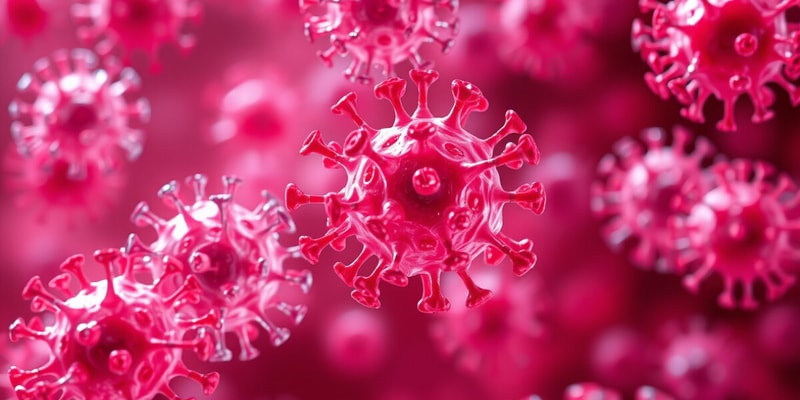Questions and Answers
What is the primary function of helper T cells in the immune response?
Which cells have T cell receptors that can only recognize peptide antigens?
Where does the process of VDJ rearrangement take place for T cells?
What is the role of MHC class I molecules in the immune system?
Signup and view all the answers
What must happen for a naive T cell to become an effector T cell?
Signup and view all the answers
Which type of antigen presenting cell is primarily associated with MHC class II molecules?
Signup and view all the answers
Which of the following is true regarding T cell receptors?
Signup and view all the answers
How do cytokines influence T cell differentiation?
Signup and view all the answers
What is the primary role of the variable domains in the alpha and beta chains of the T cell receptor?
Signup and view all the answers
How does the T cell receptor differ from the B cell receptor regarding antigen binding sites?
Signup and view all the answers
What triggers T cell activation after the T cell receptor binds to antigen?
Signup and view all the answers
What is the consequence of a T cell encountering its antigen without co-stimulation?
Signup and view all the answers
What do ITAM regions in the CD3 complex facilitate?
Signup and view all the answers
Which component of the IL-2 receptor is essential for high-affinity binding of IL-2?
Signup and view all the answers
Which chain in the CD3 complex has the highest number of ITAM regions?
Signup and view all the answers
What is the primary function of CD28 on a T cell?
Signup and view all the answers
Which transcription factors are activated due to signaling through the T cell receptor?
Signup and view all the answers
What does ZAP-70 do once activated?
Signup and view all the answers
Which cytokine is produced by the activated T cell and is crucial for T cell proliferation?
Signup and view all the answers
What best describes the role of the immune synapse?
Signup and view all the answers
In which type of T cell is CD4 primarily expressed?
Signup and view all the answers
What is the term for T cell division triggered by IL-2?
Signup and view all the answers
Study Notes
Immune Response Fundamentals
- Adaptive immune response is highly specific, differentiating between friendly bacteria and deadly pathogens by recognizing antigens.
- Key cells involved are lymphocytes: B cells and T cells.
T Cell Development and Types
- T cells mature in the thymus through a process called VDJ rearrangement, producing diverse T cell receptors (TCRs).
- Two main T cell types:
- Helper T cells (CD4+): Support other immune cells.
- Cytotoxic T cells (CD8+): Kill infected or cancerous cells.
T Cell Activation
- Naive T cells are primed and activated to become effector T cells upon stimulation.
- Activation requires two signals:
- Signal 1: TCR binds to peptide antigens presented on MHC molecules.
- Signal 2: Co-stimulation occurs when CD28 on T cells binds to B7 on antigen presenting cells (APCs).
Major Histocompatibility Complex (MHC)
- MHC molecules display antigens to T cells.
- MHC Class I: Presents to CD8+ T cells, found on all nucleated cells.
- MHC Class II: Presents to CD4+ T cells, located on APCs (macrophages, dendritic cells).
T Cell Receptor (TCR) Structure
- TCR consists of an alpha chain and beta chain with variable and constant domains.
- Antigen binding occurs at the variable domains.
- T cell receptors are surface-bound; they cannot be secreted, unlike B cell receptors.
Immune Synapse and Signaling
- The immune synapse forms between the T cell receptor, MHC-antigen, CD4/CD8, and B7-CD28 interaction.
- Activation signals are transmitted to the nucleus using CD3 complex chains.
ITAMs and Signal Transduction
- CD3 complex contains immune receptor tyrosine-based activation motifs (ITAMs).
- ITAM phosphorylation is essential for T cell activation; requires both bound CD4/CD8 and the MHC antigen.
- Kinase Lck phosphorylates ITAMs, enabling ZAP-70 kinase to bind and propagate the signal.
Transcription Factor Activation
- ZAP-70 phosphorylates LAT and SLP-76, triggering pathways that activate transcription factors NFkappaB and NFAT.
- These factors promote cytokine expression (e.g., IL-2) and cell survival markers (e.g., Bcl-2).
IL-2 and Clonal Expansion
- Activated T helper cells produce IL-2, upregulating their high-affinity IL-2 receptor (alpha, beta, gamma components).
- Autocrine stimulation occurs as T cells bind IL-2 they produce, leading to rapid cell division (clonal expansion).
Recap of T Cell Types and Activation Signals
- Two T cell types are CD4+ (helper) and CD8+ (cytotoxic).
- Activation requires:
- Signal 1: Antigen-MHC interaction.
- Signal 2: CD28-B7 co-stimulation.
- Successful activation leads to IL-2 receptor upregulation, promoting proliferation and differentiation of T cells.
Studying That Suits You
Use AI to generate personalized quizzes and flashcards to suit your learning preferences.
Description
Dive into the specifics of the adaptive immune response in this quiz. Learn about B and T cells, their receptors, and the process of VDJ rearrangement in T cells. Test your knowledge on how the immune system differentiates between friendly and harmful invaders.




